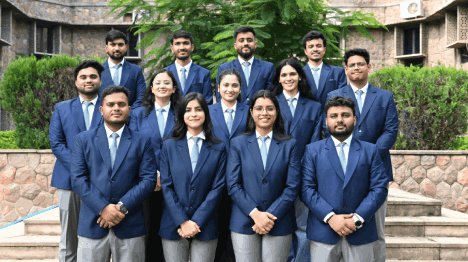- About Us
- Academics
Schools
Programs
General Information
- Faculty
The faculty members and researchers working at IIHMR University come from varied backgrounds including, but not limited to medicine, public health, management, economics, statistics, demography, human geography, social and behavioral sciences, rural development and pharmaceuticals.
- Admissions
- Research
.Publications & Journal
- Executive Education
Executive Programmes
- Online Certification Courses
ONLINE CERTIFICATION Courses
- Training
- Placements
- Fee Payment
- NAAC
- IQAC
- NIRF
- Webinars
- About Us
- About IIHMR University
- Board of Management
- Academic Council
- Board of Studies
- Research Board
- Institutional Review Board
- Finance & Audit Committee
- Departmental Research Committee
- Chairperson's Message
- President's Message
- IIHMR University Act
- Infrastructure
- Collaboration
- Ranking
- Board of Studies (School of Digital Health)
- Awards & Accolades
- Academics
- Institute of Health Management Research
- School of Pharmaceutical Management
- School of Development Studies
- School of Digital Health
- SD Gupta School of Public Health
- MBA (Hospital and Health Management)
- MBA (Pharmaceutical Management)
- MBA (Development Management)
- MBA (Healthcare Analytics)
- Master of Public Health
- Student Manual – Cohort 9 (2021-2023)
- Master of Public Health Offered by Johns Hopkins Bloomberg School of Public Health, USA in cooperation with IIHMR University, Jaipur, India
- Ph. D.
- MBA CSR & ESG Management (Executive)
- MBA Sustainable Business Management (Executive)
- Common Information for all the Programs
- Academic Calendar
- Student Handbook 2020-21
- Committees
- Policies
- Annual Exam Calendar
- Library
- Faculty
- Officers of University
- Dean of Institute of Health Management Research
- Dean of School of Pharmaceutical Management
- Dean of School of Development Studies
- Dean of SD Gupta School of Public Health
- Dean of School of Digital Health
- School of Digital Health
- Faculty List A to Z
- Faculty List Designation Wise
- Faculty List School Wise
- Admissions
- Research
- Executive Education
- Training
- Placements
- Alumni
- Events
- Job Openings
- Contact
- Research
End line Survey for ICDS III Project in Rajasthan
Agency : Government of Rajasthan
Under the Monitoring & Evaluation Component of the ICDS-III project, periodic external evaluations during different phases of the project including baseline, end-line surveys, continuous social assessment and operations research were envisaged to be undertaken by independent organizations to assess the changes brought about by the project during the intervening period. Initially the Government of Rajasthan conducted a Baseline survey in the project area to establish the benchmark indicators for the project planning. After successful implementation of the project for two years, DWCD took up concurrent social assessment to monitor the project progress and community understanding to reconfirm or redefine their operational plan to understand the impact of their implementation strategies. The project was to conduct end-line surveys to assess the progress and achievement of the project as compared with the baseline status
The specific objectives were:
- To study the utilisation level of the ICDS services by lactating and expectant women and the impact of the ICDS program in improving the childbearing core practices like breast-feeding and colostrums intake
- To assess the extent of antenatal care of pregnant women, breastfeeding and weaning practices
- To assess growth monitoring, nutritional status and participation of the children below 72 months in pre-school activities at Anganwadi centres
- To assess the knowledge of adolescent girls about family life education
- To assess participation of the community in ICDS programs like household care and feeding practices
- To compare the results of the end-line survey with the base line results on critical indicators to appraise the progress and achievement of the ICDS project
interventions using the baseline results in Rajasthan project areas. It was a cross sectional descriptive study with the multistage sampling technique with the basic unit as household. The survey covered about 257 project areas WB old, new and general including the rural, tribal and urban areas. The total households covered by the survey were 17427.
The Endline survey observed a reduction in the percentage of underweight and severely malnourished children in the age group of 0-36 months from that in the Baseline survey. The weight at birth of the children showed an increase from the Baseline survey (16.7 percent) to Endline (29.1 percent). The practice of initiating breast-feeding within 2 hours of birth increased rapidly from 9 percent to 38.5 percent in the Endline. Colostrum feeding has increased from 20.7 percent to 45.1 percent in the Endline. The percentage of children who are exclusively breast-fed also increased from 4.7 in Baseline to 5.9 in Endline. About 78 percent of lactating mothers got registered after confirmation of the pregnancy. Doses of two T.T were received by around 90 percent of the lactating mothers.
The percentage of adolescent girls participating in the women's activities conducted by AWW was 0.9 percent in the Baseline survey against 5.5 percent in the Endline survey. The adolescent girls who got registered in the AWC were 3.5 percent in the Baseline survey and 10.2 percent in the Endline survey. The regular growth monitoring of children less than 3 years of age was 81.3 percent in the World Bank assisted projects.



